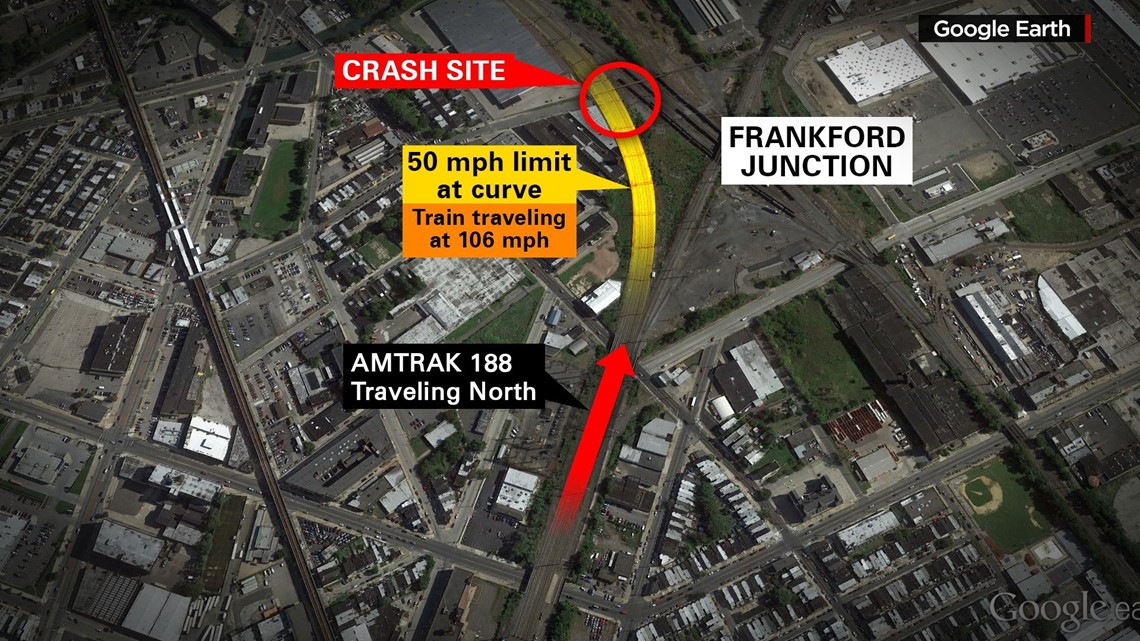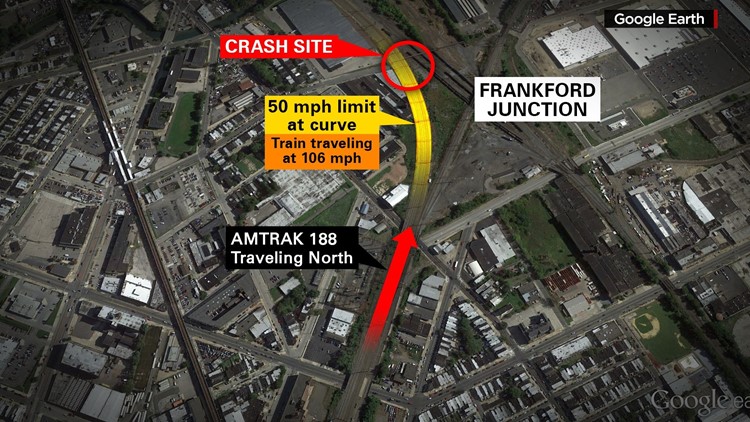

(CNN) — The investigation of an Amtrak derailment in Philadelphia that killed at least seven people and injured more than 200 will look at several factors, National Transportation Safety Board member Robert Sumwalt said Wednesday.
Those factors include “the track, the train signals, the operation of the train, the mechanical condition of the train and human performance,” he said.
“You have a lot of questions,” Sumwalt told reporters. “(And) we have a lot of questions.”
Here are some of the things investigators will consider:
Speed
Amtrak Northeast Regional Train 188 was traveling twice the speed limit for a curve at Frankford Junction, Sumwalt said.
The train was traveling about 106 mph as it headed into a left turn on a section of track with a 50 mph speed limit, he said. The speed limit immediately before the curve was 80 mph, he said.
The engineer operating the train applied full emergency brakes “just moments” before the train derailed, he said.
Trains, like airplanes, are equipped with event data recorders — better known as “black boxes” — that will officially determine its speed. Mayor Michael Nutter said the train’s recorder was recovered and sent for analysis, along with the train’s forward-facing cameras.
Robert Halstead, a railroad accident forensics expert, offered a possible scenario to CNN’s Jake Tapper.
“It’s entirely possible you had a train jackknife in such a fashion that the second and third cars are actually the ones that struck a heavy fixed obstruction, such as the bridge support, the pedestrian bridge that passed over this location and, possibly, parked train cars,” he said.
Track condition
Investigators will also consider the condition of the track. There are roughly 880,000 miles of rail track in the United States, according to Mary Schiavo, a former inspector general for the U.S. Department of Transportation and a CNN analyst, and a lot of it is in less-than-ideal shape. In Philadelphia, however, along the bustling Northeast corridor, the situation is perhaps more dire.
“It’s an extremely heavily used stretch of track,” said transportation expert Matthew Wald. “They have trouble keeping it in a state of good repair.”
Human error
It’s too early to determine whether the engineer played any role here, but some recent rail accidents have been blamed on human error.
New York commuter train engineer William Rockefeller Jr. admitted falling asleep before derailing in a 2013 Bronx crash that left four dead and 67 injured, and investigators found that a 2009 trolley crash in Boston that injured more than 60 occurred because the operator was texting his girlfriend.
Nutter told reporters the train’s engineer was injured in Tuesday night’s crash, but has been able to speak to officials. Police detectives brought him in for an interview but he refused and left with a lawyer, according to a Philadelphia police official.
The engineer was identified as Brandon Bostian. His LinkedIn profile says he has been an engineer for Amtrak since 2010 and before that a conductor for four years. Prior to Amtrak, he worked as a cashier at Target.
CNN spoke to a neighbor of Bostian near his home in Forest Hills, New York, who last saw him two weeks ago. Moresh Koya described his neighbor as “responsible” and “happy” with his job.
On Bostian’s Facebook page, friends have been posting words of encouragement. His profile picture was changed to a black box overnight, just hours after the crash, according to his profile page.
Collision with another train or vehicle
Nutter said there’s no indication that another train had anything to do with the derailment, and so far, no signs that a vehicle was involved either. The deadliest crash in the history of the New York commuter railroad occurred February 3 when a driver suddenly moved her SUV into the train’s path. The driver and five train passengers were killed.
The train’s mechanical condition
The locomotive — where the train’s engine is housed — flew off the tracks in such a manner that it was actually left standing upright. Whether mechanical failure played any role in the derailment has not yet been determined, but according to an official with the company that built it, that particular locomotive was practically brand new. A Siemens official told CNN that the high-speed electric passenger locomotive — one of 70 Amtrak ordered for service on the Northeast corridor — has only been in service since 2014.
Terrorism
A U.S. law enforcement official told CNN that so far, there is nothing to indicate the incident was an act of terrorism.
Weather conditions
According to CNN meteorologist Todd Borek, there were no weather-related conditions in the area that would have contributed to a crash. “No fog, no problems with visibility,” he said.



